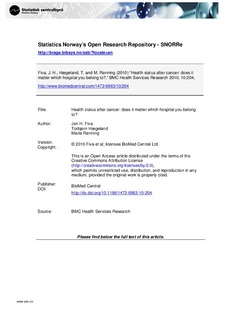| dc.contributor.author | Fiva, Jon Hernes | |
| dc.contributor.author | Hægeland, Torbjørn | |
| dc.contributor.author | Rønning, Marte | |
| dc.date.accessioned | 2012-08-27T11:52:14Z | |
| dc.date.available | 2012-08-27T11:52:14Z | |
| dc.date.issued | 2010 | |
| dc.identifier.citation | BMC Health Services Research 2010, 10:204 | no_NO |
| dc.identifier.issn | 1472-6963 | |
| dc.identifier.other | http://www.biomedcentral.com/1472-6963/10/204 | |
| dc.identifier.uri | http://hdl.handle.net/11250/177684 | |
| dc.description | Copyright on any research article in a journal published by BioMed Central is retained by the author(s). This is an Open Access article distributed under the terms of the Creative Commons Attribution License (http://creativecommons.org/licenses/by/2.0), which permits unrestricted use, distribution, and reproduction in any medium, provided the original work is properly cited. | no_NO |
| dc.description.abstract | Background: Survival rates are widely used to compare the quality of cancer care. However, the extent to which
cancer survivors regain full physical or cognitive functioning is not captured by this statistic. To address this
concern we introduce post-diagnosis employment as a supplemental measure of the quality of cancer care.
Methods: This study is based on individual level data from the Norwegian Cancer Registry (n = 46,720) linked with
data on labor market outcomes and socioeconomic status from Statistics Norway. We study variation across
Norwegian hospital catchment areas (n = 55) with respect to survival and employment five years after cancer
diagnosis. To handle the selection problem, we exploit the fact that cancer patients in Norway (until 2001) have
been allocated to local hospitals based on their place of residence.
Results: We document substantial differences across catchment areas with respect to patients’ post-diagnosis
employment rates. Conventional quality indicators based on survival rates indicate smaller differences. The two sets
of indicators are only moderately correlated.
Conclusions: This analysis shows that indicators based on survival and post-diagnosis employment may capture
different parts of the health status distribution, and that using only one of them to capture quality of care may be
insufficient. | no_NO |
| dc.language.iso | eng | no_NO |
| dc.publisher | BioMed Central | no_NO |
| dc.subject | Cancer | no_NO |
| dc.subject | Kreft | no_NO |
| dc.subject | Kreftbehandling | no_NO |
| dc.subject | Sykehus | no_NO |
| dc.subject | Yrkesdeltakelse | no_NO |
| dc.subject | Arbeid | no_NO |
| dc.subject | Employment | no_NO |
| dc.subject | Health care expenditures | no_NO |
| dc.subject | Hospital treatment | no_NO |
| dc.subject | Sykehusbehandling | no_NO |
| dc.subject | Regional variation | no_NO |
| dc.subject | Yrkesaktivitet | |
| dc.subject | Scientific article | |
| dc.title | Health status after cancer: does it matter which hospital you belong to? | no_NO |
| dc.type | Journal article | no_NO |
| dc.type | Peer reviewed | no_NO |
| dc.subject.nsi | VDP::Medical disciplines: 700::Clinical medical disciplines: 750::Oncology: 762 | no_NO |
| dc.subject.nsi | VDP::Social science: 200::Economics: 210 | no_NO |
| dc.source.pagenumber | 13 s. | no_NO |
| dc.source.volume | 10 | no_NO |
| dc.source.journal | BMC Health services research | no_NO |
| dc.source.issue | Art No. 204 | no_NO |
